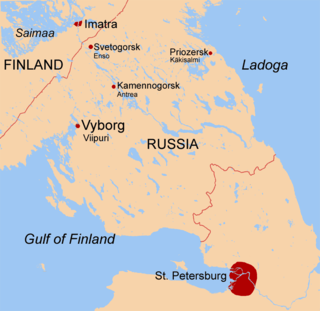
The Karelian Isthmus is the approximately 45–110 km wide stretch of land, situated between the Gulf of Finland and Lake Ladoga in northwestern Russia, to the north of the River Neva. Its northwestern boundary is the relatively narrow area between the Bay of Vyborg and Lake Ladoga. If the Karelian Isthmus is defined as the entire territory of present-day Saint Petersburg and Leningrad Oblast to the north of the Neva, the isthmus' area covers about 15,000 km2.
Vesikko is a submarine, which was launched on 10 May 1933 at the Crichton-Vulcan dock in Turku. Until 1936 it was named by its manufacturing codename CV 707. Vesikko was ordered by a Dutch engineering company Ingenieurskantoor voor Scheepsbouw in 1930 as a commercial submarine prototype. Purchased by the Finnish before the war, she saw service in the Winter War and World War II, sinking the Soviet merchant ship Vyborg as her only victory. After the cease-fire with the Allies in 1944, Vesikko was retired. Finland was banned from operating submarines after the war and she was kept in storage until she was turned into a museum ship.

Vyborg Castle is a Swedish-built medieval fortress around which the town of Vyborg evolved. The first record of the castle dates back to 1293. Currently it serves as a museum.
Finnish Jews are Jews who are citizens of Finland. The country is home to approximately 1,500 Jews, who mostly live in Helsinki. Jews came to Finland as traders and merchants from other parts of Europe.
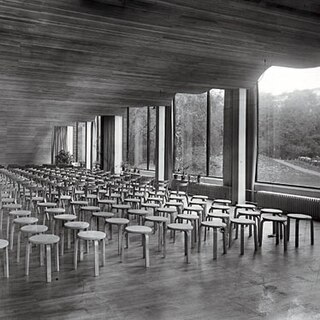
Vyborg Library is a library in Vyborg, Russia, built during the time of Finnish sovereignty, before the Finnish city of Viipuri was annexed by the former USSR and its Finnish name was changed to Vyborg by the USSR authorities.

Vyborg is a railway station, located in the town of Vyborg in Leningrad Oblast, Russia.

The Saint Petersburg–Hiitola railway is a 170-kilometer (110 mi) long railway with 1,520 mm broad gauge located in St. Petersburg, Leningrad Oblast and Republic of Karelia, which links Finlyandsky Rail Terminal to Khiytola through Devyatkino, Vaskelovo, Sosnovo, Priozersk and Kuznechnoye. Originally built by Finnish State Railways in the Grand Duchy of Finland, the railway was part of a trunk line from Vaasa by the Gulf of Botnia to St. Petersburg. In the 1940 Moscow Peace Treaty the territory was ceded by Finland to the Soviet Union. The railroad is now operated by the Russian Railways. The railroad is used by passenger trains between St. Petersburg and Sortavala. The track between Khiytola and Sortavala is a part of the Vyborg–Joensuu railroad completed in 1894.
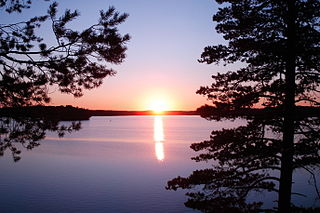
Vyborgsky District is an administrative and municipal district (raion), one of the seventeen in Leningrad Oblast, Russia. It is located in the northwest of the oblast on the Karelian Isthmus and borders with Priozersky District in the northeast, Vsevolozhsky District in the east, Kurortny District of the federal city of St. Petersburg in the south, Kymenlaakso and South Karelia regions of Finland in the northwest, and Lakhdenpokhsky District of the Republic of Karelia in the north. From the southwest, the district is limited by the Gulf of Finland. The area of the district is 7,475.472 square kilometers (2,886.296 sq mi). Its administrative center is the town of Vyborg. Population : 120,446 (2010 Census); 113,748 ; 108,571 (1989 Census).
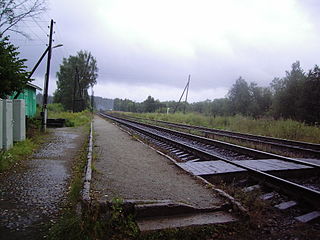
The old Karelian railroad between Viipuri (Viborg) and Joensuu is a railway with 1,524 mm broad gauge, which used to link Joensuu, Sortavala, Hiitola, Antrea and Viipuri (Vyborg). Originally built in 1892-1894 by Finnish State Railways in the Grand Duchy of Finland, in the 1940s most of the railway up to Niirala was ceded by Finland to the Soviet Union in the Moscow Peace Treaty, Moscow Armistice and Paris Peace Treaty as a result of the Winter War and Continuation War. Now the track is located in Leningrad Oblast, Republic of Karelia and North Karelia. The Sortavala – Joensuu link across the border was abolished after the Continuation War, but was since restored and is currently in use for cargo traffic.
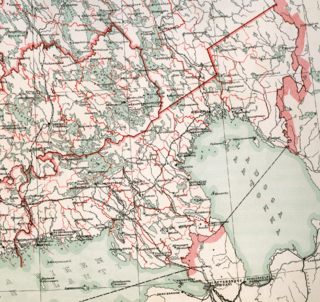
The Viipuri Province was a province of Finland from 1812 to 1945.

Helsinki Synagogue in the city of Helsinki (Helsingfors) is one of the two synagogues in Finland. Located in the Kamppi (Kampen) district, the synagogue is used by the 1,200-strong Jewish community of Helsinki. The synagogue building, designed by the Viipuri-born architect Jac. Ahrenberg (1847-1914), was completed in 1906.
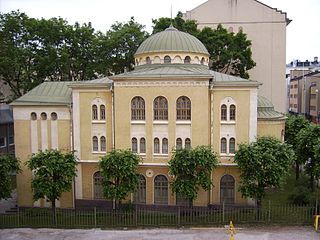
Turku Synagogue in the city of Turku is one of the two synagogues in Finland. Located in the VII District, the synagogue is used by the Jewish community of Turku. The synagogue building, designed by architects August Krook and J.E. Hindersson, was completed in 1912.

Allegro is a high-speed train service between Helsinki, Finland, and St. Petersburg, Russia. The service started on 12 December 2010. The aim is to reduce travel time between Helsinki and Saint Petersburg: before Allegro, the journey time was 5½ hours; currently it is 3 hours and 27 minutes and there are plans to bring it down to 3 hours. The name Allegro is a musical term for a quick tempo, thereby suggesting "high speed".

Vyborg town wall was a defensive structure built around the town of Viborg. It was completed during the Swedish era in the 1470s and demolished mainly in the 1860s as Vyborg was a part of the Grand Duchy of Finland. Some minor parts of the wall are still preserved as well as two round towers.

The Hermitage-Vyborg Center is an external branch of the Saint Petersburg based Hermitage Museum in the Russian town of Vyborg. The museum was opened in 2010. Hermitage-Vyborg Center is located in the 1930 completed Vyborg Art Museum and Drawing School building, which was designed by the Finnish architect Uno Ullberg.
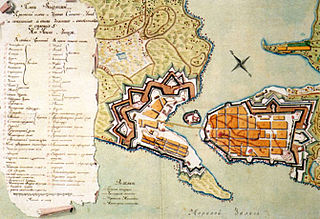
Annenkrone is an early 18th century fortification in Vyborg, Russia. It is located outside the town in the island of Tverdysh.

Vyborg Shipyard PJSC is a shipbuilding company located in Vyborg, Russia. The company has a focus on icebreakers and other icegoing vessels for arctic conditions, but the company has also built deep sea semi-submersible floating drilling and production platforms for exploration of oil and gas offshore fields. Vyborg Shipyard employs more than 1,500 people.

Hjalmar Fabian Parikka was a Finnish revolutionary soldier, actor and artistic director.
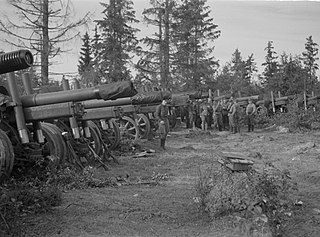
The Battle of Porlampi, also known as the Battle of Porlammi, was a military engagement fought between the Finnish Army and Red Army from 30 August to 1 September 1941 on the Karelian Isthmus. The battle was fought near the town of Porlampi during the second month of the Continuation War. The battle was a Finnish victory and effectively ended the reconquest of Karelia.





















